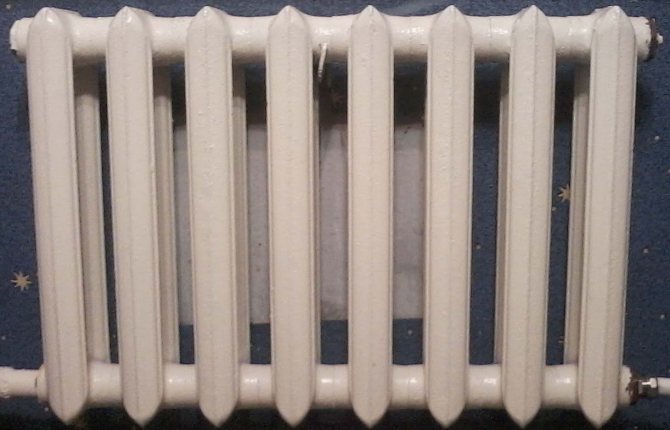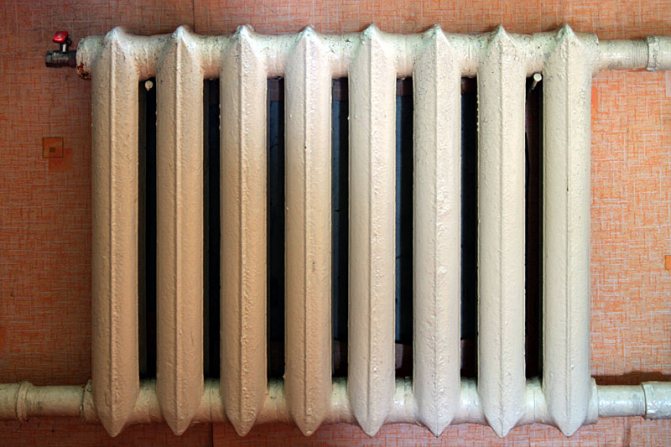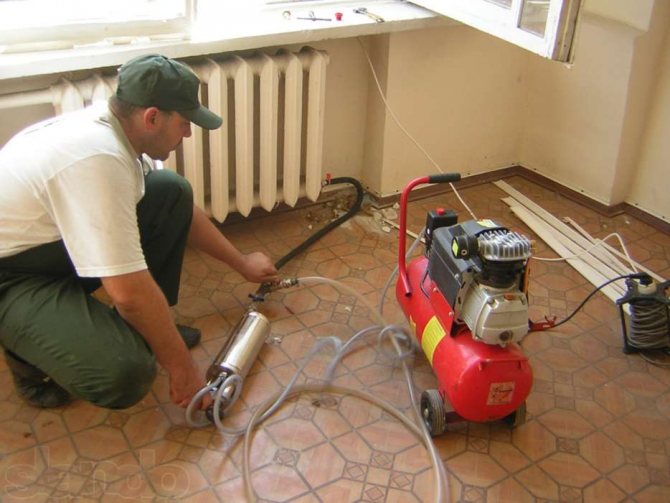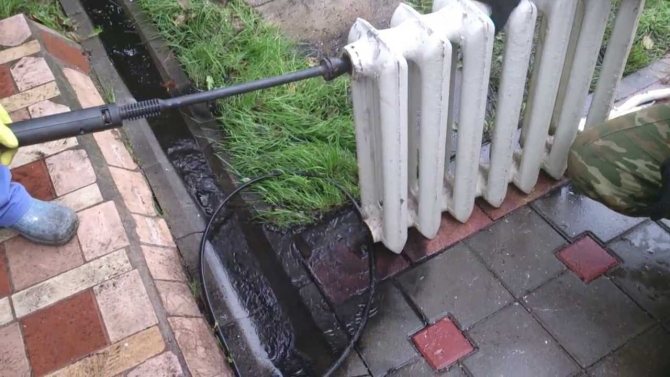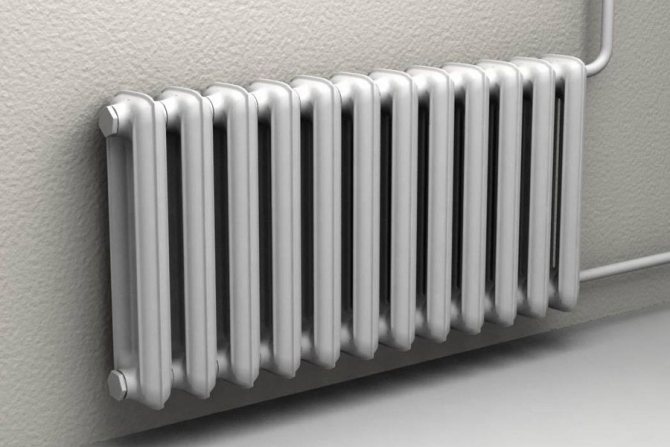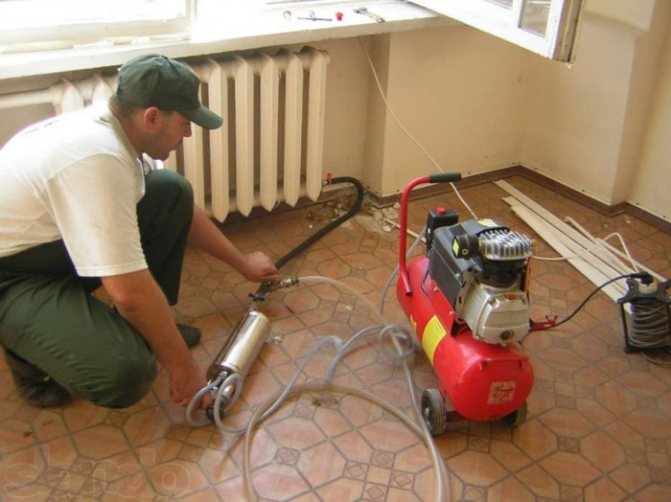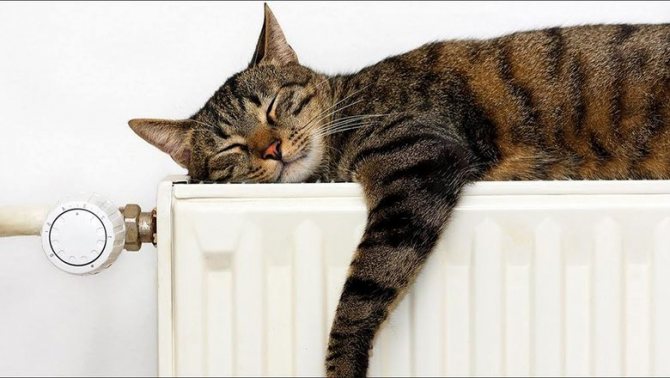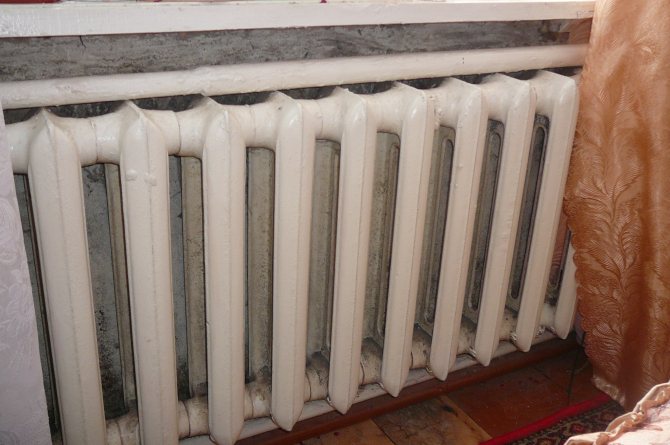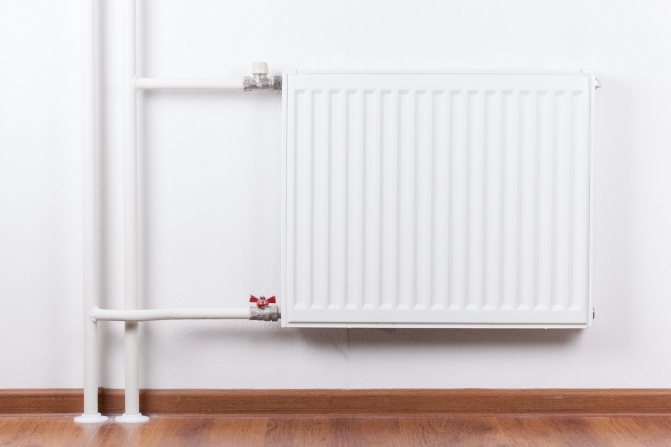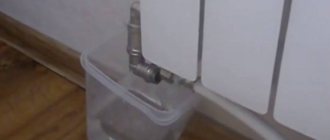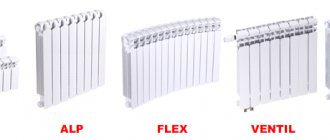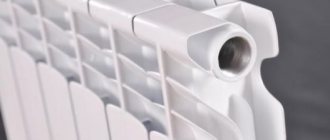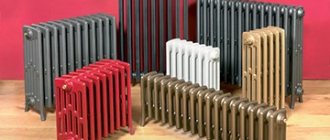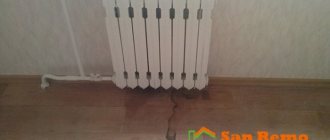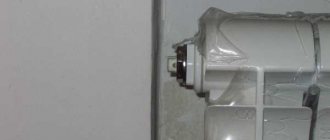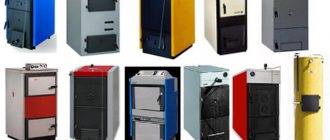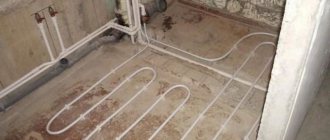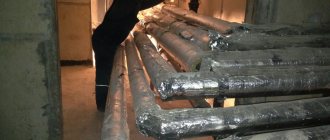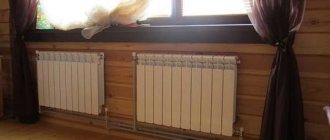Do I need to rinse from the inside
The local heating system is installed mainly in private facilities that are located outside the city. The owner of the house updates the contents of the boiler himself. Batteries last longer as only fresh heating fluid circulates. They also need cleaning, but this is more of a preventive procedure. General is held less often, for example, once every 5 years.
Employees of the central heating organization update the content of the line much less frequently. Most often, the oily substance is diluted with a new one, refreshing it. The volumes are not enough to frequently update everything. Thus, over the decades, the slurry circulating through the batteries of high-rise buildings differs in composition from its original state.
Radiators gradually begin to give off heat worse. Insoluble elements or reaction products of the material with impurities of the circulating substance accumulate on the walls. Eventually, a blockage occurs, which leads to disastrous and costly consequences.
Regular preventive maintenance of the heat exchanger will help to avoid trouble. There will be no need to worry about the fact that soon it will be necessary to update an expensive heating system due to its failure.
To figure out how to clean any heating battery yourself, you first need to find out the nuances of the structure of modern models of radiators.
Important: the main thing in such a situation is compliance with safety regulations. Damaging a product while leaving is not the worst thing that can happen. Remember that there is almost always liquid inside the battery.
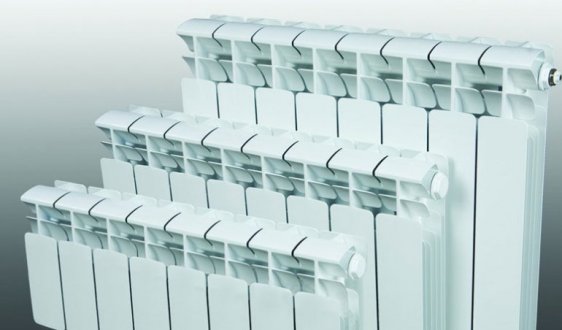
Types
Before cleaning the heating system, you first need to determine the metal of the batteries.
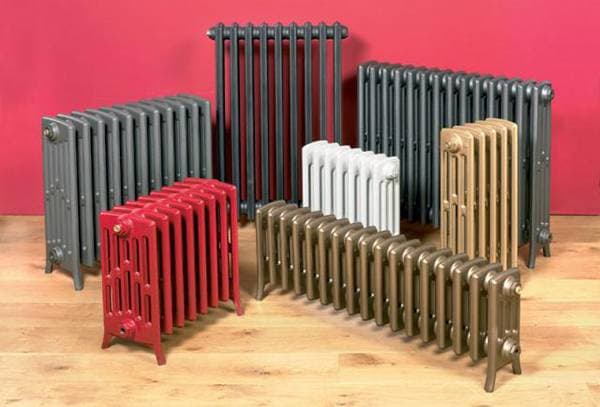

Aluminum radiators must not be cleaned in the same way as copper-brass and cast iron. This is due to the fact that the former do not use solder in their design and this metal reacts negatively to caustic soda.
Aluminum is a more reactive metal than copper-brass and can be dissolved with caustic soda. Because of this, these radiators undergo a different cleaning process.
As long as the refrigerant is regularly changed and flushed, aluminum radiators do not need flushing.
Copper-brass and cast iron radiators can be cleaned in any way possible.
Features of radiators
In new or old apartments of the Khrushchev type, mainly cast-iron batteries, the so-called accordions, are installed. They are renowned for their long life and stay warm for a while after the hot liquid has stopped renewing. Cast iron tolerates work with pressure drops in the system and low-quality contents more easily. But such radiators are also more expensive.
Products made of bimetallic material are cheaper, thinner and lighter. They differ in increased heat transfer, but they also cool down quickly. They are easier to clean from the outside and look more aesthetically pleasing.
They clog less often, because they are made of a smoother material, to which less dirt sticks. But bimetallic batteries often burst, unable to withstand a sudden pressure surge in the system. This is not uncommon at the beginning of the heating season or during sudden temperature changes. Therefore, they are preferred to be used in private homes or commercial buildings.
Aluminum products are the cheapest, but they are fragile and short-lived.Apartments with an old heating system quickly lose their functionality.
During the maintenance process, each type of battery must be considered individually.
Centralized battery flushing
Self-cleaning of one element of the central heating system may not bring results - contamination in the riser will quickly lead to re-clogging. In this case, centralized flushing will be required.
To achieve it, you must:
- Get the consent of your neighbors.
- Write a corresponding statement to the management company.
- Pay for the service.
All work will be carried out by the staff of the management company, while the dismantling of the radiators is not required. However, it is quite difficult to obtain the consent of other tenants, since each apartment owner will have to pay for the procedure.
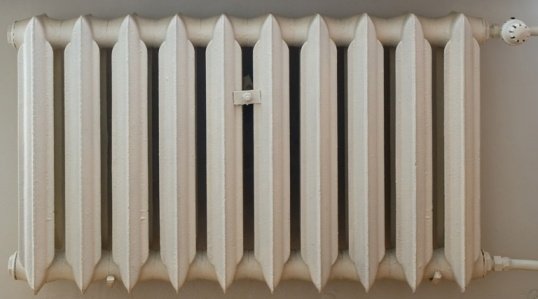

Classification
Radiator cleaning procedures are divided into different types, depending on the aids used and the area of exposure.
There are much more options, but only those that can be done independently and at home without the use of specific equipment will be covered.
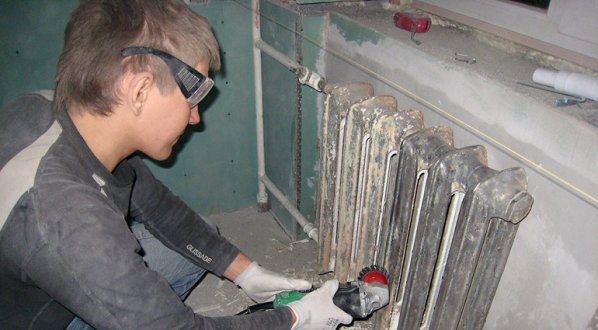

Outdoor
It is used to refresh the appearance of the product, remove accumulated dust, dirt and renew the upper protective paint layer. In turn, it happens:
- Chemical - requires the use of active substances that enhance the effectiveness of cleaning with a damp sponge or microfiber cloth.
- Mechanical - used to remove the outer coating in order to renew it. In this case, such tools are involved: grinder, brush, sandpaper, etc. Using additional means, you should pay special attention to the joints of the sections and the line with the battery, so as not to damage them.
- Thermal - also used to remove a layer of paint from a cast-iron battery. An industrial hair dryer or blowtorch will do the job faster, but the rubber seals between the segments are also affected. If there is no desire to disassemble the battery into links, it is better to refuse this method.
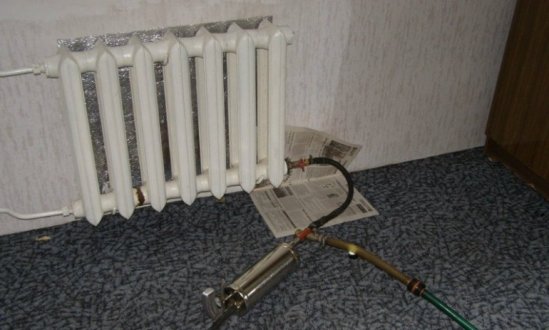

Internal
Responsible for the quality of heat transfer from the radiator and its throughput.
- Mechanical requires the use of a brush or wire with a hook, with the help of which the limestone build-up is scraped off or chipped off. Specialists in this case use a blowing station. Then the product is rinsed with water from the inside and mounted in its original place.
- Chemical is often performed after mechanical to enhance the effectiveness of the latter, but it can also be an independent procedure. It requires the mandatory use of an active substance that will dissolve or weaken the structure of deposits inside the product.
Important: in some cases, dry cleaning will not give the expected result, because it is rare under the influence of temperature, but a conglomerate is formed that cannot be washed off. The only way out is to buy a new heat exchanger.
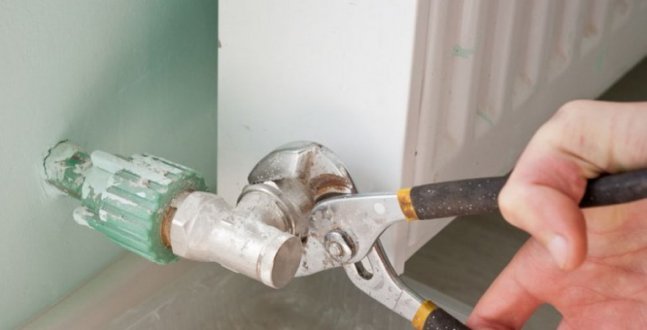

Appliances
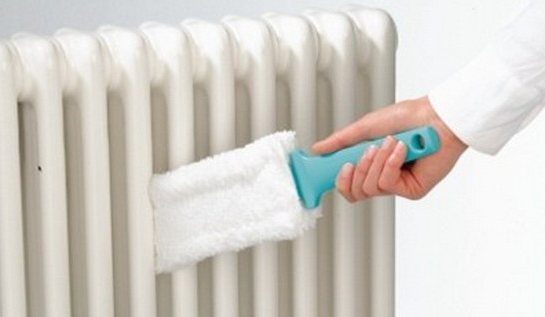

Some household appliances will help to wash the heating batteries and clean them of contamination:
- Use a vacuum cleaner. If it is supplemented with a narrow nozzle, it will come in handy when cleaning heating devices. First, remove all dust on the inside, then carefully treat the outside. After this procedure, you can wipe the radiator with a damp cloth.
- A hairdryer will also help. Using it is quite simple: hang a damp towel or any sufficiently thick cloth, also pre-moistened, behind the battery. Now turn on the hair dryer and start blowing hot air onto the radiator. All dust will fly off the surface and settle on the damp material. Nevertheless, some of the dirt can remain between the sections or settle on the floor and walls.
- The steam generator will help to wash the batteries "accordion". If you have such a device, turn it on and direct a jet of hot steam towards the heater.Thermal exposure will dissolve even old dirt and additionally disinfect the batteries, which is sometimes necessary. To protect all surrounding surfaces, cover them with oilcloth or old cloth. And remember that hot steam can damage the finish, especially if the paint has been applied for a long time and in one coat.
- Other appliances such as a steamer and an iron also produce steam, but they are not as convenient to use for cleaning. And the steam generator delivers a jet of hot air under pressure, thanks to which it penetrates into narrow areas and hard-to-reach areas.
- Use an electric kettle. First, place a wide baking sheet or other large flat container under the battery, then boil water and pour it onto the heater from above along the entire length, as well as from the sides. Water and dust will drain into the baking sheet and collect in it. The electric kettle can be replaced with an ordinary one. It is convenient to clean in this way old battery.
We recommend: Washing laminate flooring at home
Preparing for flushing
Make no mistake that this is easy to do, especially when it comes to cast iron. But if you approach the situation wisely and your hands “grow from where you need to”, two men will cope with the task.
Preparation technology:
- It is better to choose a day until mid-autumn, when the services have already blown through the main, but the water has not yet been launched into the system. Ideally, you should clean the batteries for all the neighbors in the riser at the same time. Otherwise, the dirt in the radiator, which is in another apartment, will end up in yours, and the procedure will become useless.
- It is not difficult to drain the water from the system in a private house and you can do it whenever you want. In an apartment building, you will have to agree with a plumber so that he can carry out all the manipulations in the basement, where the distribution unit of the house is located. It is necessary to notify the neighbors if this happens during the heating season. Although the latter is resorted to when there is a blockage. It is better to carry out routine cleaning of radiators in the summer.
- If there is only superficial knowledge about the operation of batteries, their connection to the system and other nuances, it is better to study the materiel first. Or call a professional.
- Prepare the container in advance, where the remaining liquid will drain.
- Having unscrewed the element, you need to remove it. At this stage, you will need an assistant. Even a bimetallic product is inconvenient to dismantle alone.
- Inspect the coolant. Maybe there is no point in cleaning it anymore.
- If you plan to rinse the product with water in a bathtub, you need to put something under it. For example. silicone mat. Otherwise, the scratches on the container will be so serious that you will have to pay for the restoration of the bath later.
Advice: if the connections are welded, a torch or other tool must be used to heat the sleeve.
Features of cleaning during the heating period
Under certain circumstances, you can perform the procedure in the winter. In this case, you need to pay attention to the following points:
- the method of cleaning and the special agent are similar;
- flushing in a local system eliminates the need to disconnect and remove all thermal elements;
- before the procedure, you need to notify the plumber of the housing and communal services that serves the house;
- When dismantled, hot oily liquid will pour out of the battery, not cold water residues. And a lot of it will flow.
The specifics of cleaning in a private house
A number of features of caring for a local heating system:
- The heat carrier is most often water, and it is not always filtered. Dirt, circulating through the pipes, gets stuck in each element.
- It is not only the radiator that needs purging or flushing, but the entire line, otherwise the procedure loses its meaning.
- The shutdown of one coolant during the heating season is carried out only if there is a leak or similar problems.
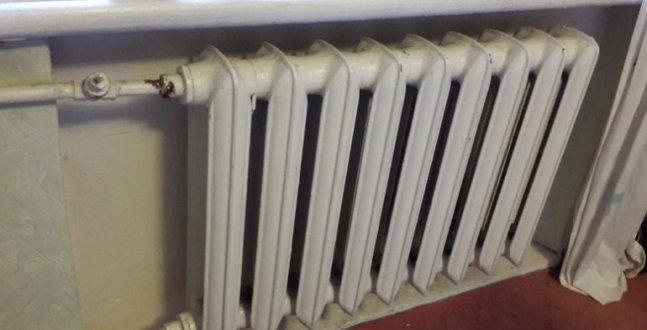

Features of radiators in Khrushchev
Older houses have a one-pipe system. The coolant is fed from the bottom up, and then goes along the return line to the drainage line, which is located in the basement. In this regard, on the lower floors in neighboring apartments, there may be different rates of heat transfer from radiators. Cleaning or replacing the battery with a new one will help solve the problem if the old one is badly worn out and clogged.
The disadvantage of one-pipe systems is rapid wear and clogging of risers, radiators and lines. If you make a cut of a 20-year-old cast-iron battery, which has served since the day of installation in the Khrushchev apartment, you can see a lime build-up that almost halves the passable diameter. It also reduces the heat transfer of the element. To find out how to wash a battery in a Khrushchev, it is better to consult a plumber.
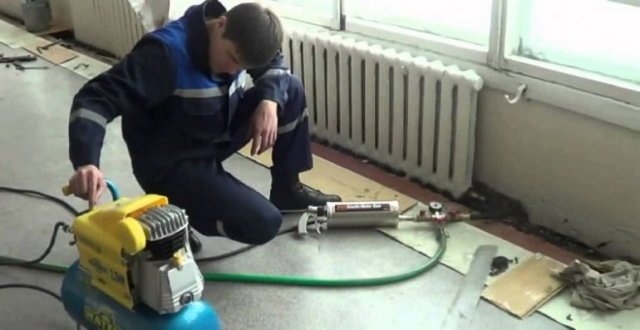

Folk ways
You can wash heating radiators with high quality if you follow the advice of experienced housewives, since many of them are very creative in this matter.
Hydrogen peroxide will help to clean and additionally disinfect the battery. This is especially true in homes where allergy sufferers live. The product must be applied to a rag. Wrap a brush (or just a stick) with a rag and methodically wipe the heater in each section.
It so happens that not only dirt has accumulated in the battery, but an unpleasant smell has also settled. This is possible if, for example, a poorly washed item has been dried on a heating element. In this case, citric acid will help. You need to dissolve three teaspoons of the product in a glass of warm water. With this composition, wipe the radiator from all sides and between the sections.
You can also use nine percent vinegar for washing. They wipe the battery or spray it on it (without diluting it with water). If the household has only vinegar essence, it should be dissolved in water (ten parts of water are taken for one part of the essence). After treatment with an acidic composition, the battery must be properly wiped off or simply rinsed with clean water.
You can also use regular baking soda dissolved in water. To be sure, this composition is supplemented with apple cider vinegar and soap solution. The washing effect will be more noticeable.
Also, chalk dissolved in water is used to process the battery.
To accurately get to the most inconvenient places in the battery, housewives are advised to use soapy household gloves. Put them on your hands, soak them in soapy water, and use your fingers to scrub the dirt out of tight spots. If you don't have gloves, you can use an old sock. If the battery is hot, unnecessary gloves will do.
For cleaning the most uncomfortable and narrow places, some of the more patient people use a disused toothbrush.
We recommend: How to clean the microwave with vinegar?
To avoid having to resort to clever ways to clean your radiators, it's best to wash them every time you clean your home. This will save the battery from accumulating a lot of dirt. Then general cleaning of heating elements will have to be arranged only a couple of times a year - before and after the end of the heating season.
For more information on how to wash the batteries inside, see the next video.
How to clean the heating battery yourself
Before dismantling work, you must drain all the liquid from the line. Therefore, it is not recommended to do this in winter, since there is more water and, accordingly, no less trouble.
If the procedure is not prophylactic, it should be cleaned with a special tool. It can be made from scrap materials or bought.
Important: if you need to flush out the contents of a cast iron radiator, you must remove all plugs.
The sequence of actions for the apartment option:
- First flush - filling with hot water. It should not be boiling water, because it contains a large amount of insoluble salts, which will stick to the walls of the product again.Plug outlets and shake battery well. Drain everything.
- The second wash is a control one with an additional substance. It is better to prepare the solution in advance. When using a chemical, the amount is regulated by the manufacturer, which is indicated in detail on the packaging. For each homemade drug based on a folk recipe, a separate individual measure is indicated.
- After pouring liquid into the heat exchanger, you need to plug all the holes again and leave the product in this position for several hours.
- Returning to the radiator, shake it so that the layers of limescale and other dirt, which have softened under the influence of the active substance, fall off.
- Remove plugs and allow contents to drain.
- Pour clean warm water several times to wash off the remaining reagent.
Advice: it should be remembered that when cleaning the element in the bathroom, you will then need to remove from the container everything that has flowed out of the radiator.
If you ignore the last procedure and do not remove the residues of foreign matter, this may later cause deformation or destruction of the material of which the product is made.
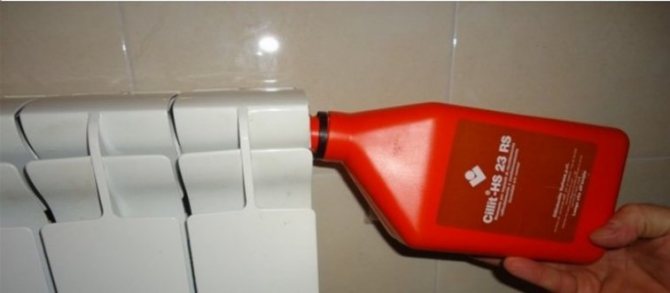

The nuances of cleansing outside
Guidelines for removing contaminants from the outside boil down to simple steps:
- The same vacuum cleaner or steam generator will do. In the second case, protect the wall behind the radiator panel and the floor from moisture by covering them with a film. The device additionally disinfects the battery.
- Quickly removes dust by blowing with a hair dryer: place a wet rag on the wall to which the radiator is fixed, “blow out” the dirt (it will settle on the fabric).
- Use a scraper, scrubber, or brush to wipe off stubborn dirt.
- Wipe the surface with a cloth dampened with soapy water. Wipe dry.
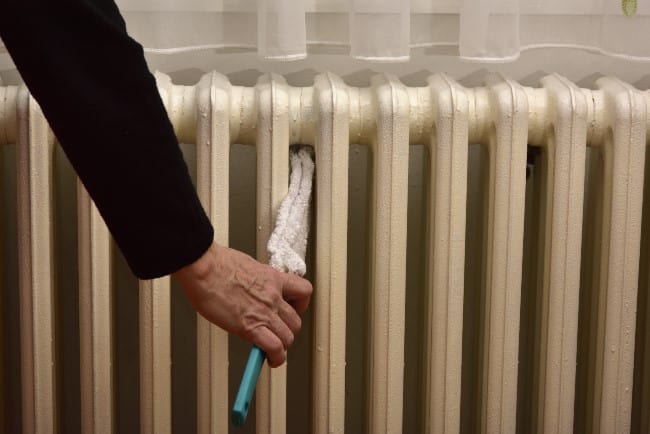

It is easier to clean the radiators from dust and dirt from the outside
In advanced cases, use chemicals or detergents that remove grease, dirt, plaque. Place rags under the batteries so that dirty smudges do not form on the floor after spraying.
Overview! Blinds cleaning brushes
Don't forget about boiling water rinsing and manual cleaning. To enhance the effect, use vinegar, soda, citric acid, alkali, making sure that the home remedy is compatible with the material of the heating batteries.
Larisa, 25 July 2020.
Subscribe to the channel Modern Housekeeping in Yandex.Zen
Save and share information on social networks:
Recommended to read
- Paste from Dr. Beckmann

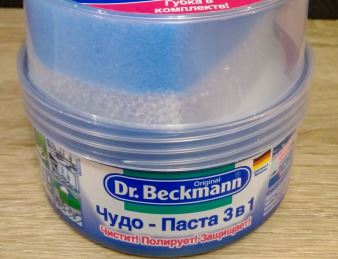
Chemical cleaning agents inside: table
| Substance | Application |
| Vinegar essence (concentrate, not table 9% analogue) |
|
| Soda ash or caustic soda |
|
| Lemon acid (recommended for local systems) |
|
| Car radiator cleaner (prohibited for use with aluminum or bimetallic batteries) | Proceed according to the instructions on the package. |
Important: chemicals that attack rust and limestone can cause leaks. For example, alkalis are softer than acids.
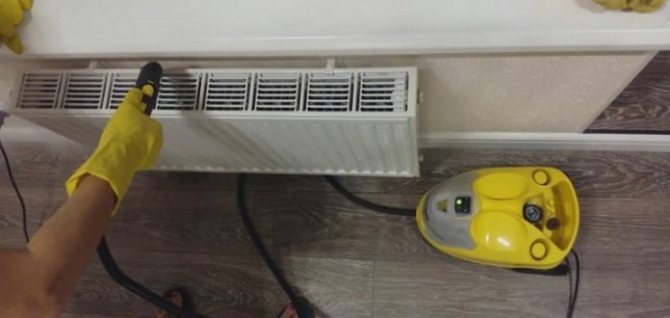

Detergent
How and how to wash radiators? Of course, when cleaning the radiator, we cannot do with water alone. Such substances and solutions will be effective and useful:
- Alkali.
- Means for washing vehicle radiators.
- Lemon acid.
- Caustic soda.
- Acetic acid. Some also use essence (70% solution).
- Milk serum.
- Means for cleaning sewer pipes like "Mole".
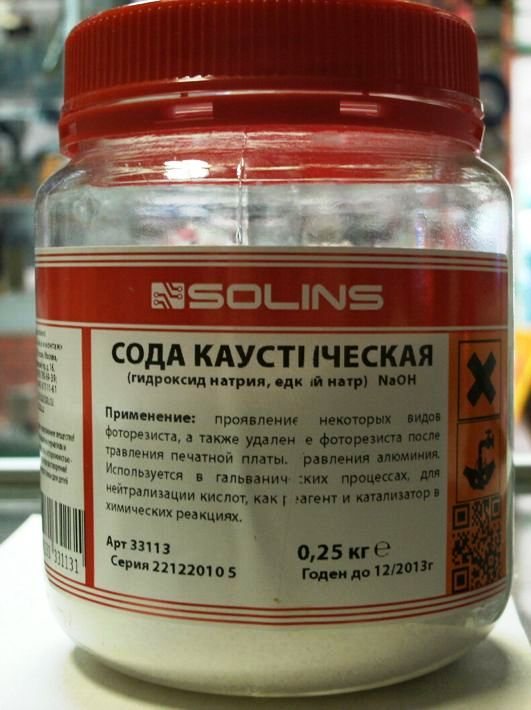

Caustic soda


Milk serum
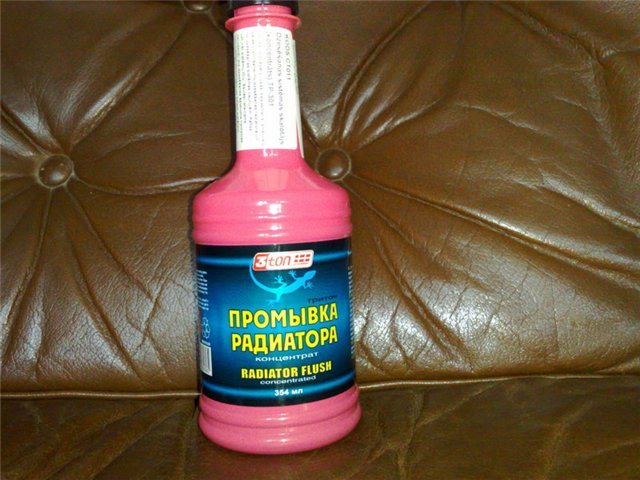

Car Radiator Cleaner
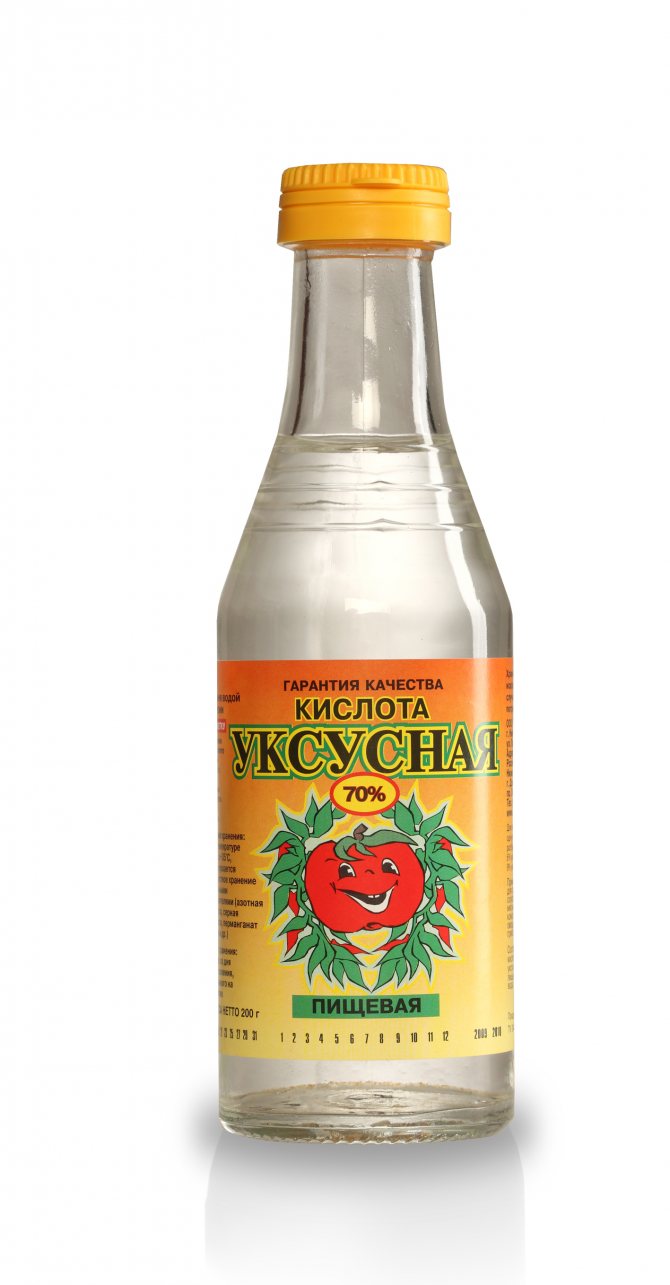

Essence
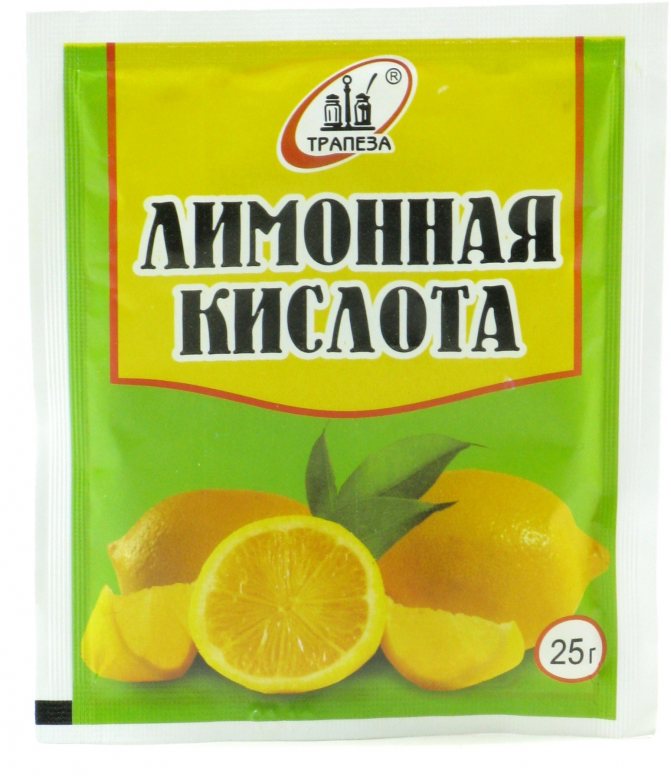

Lemon acid
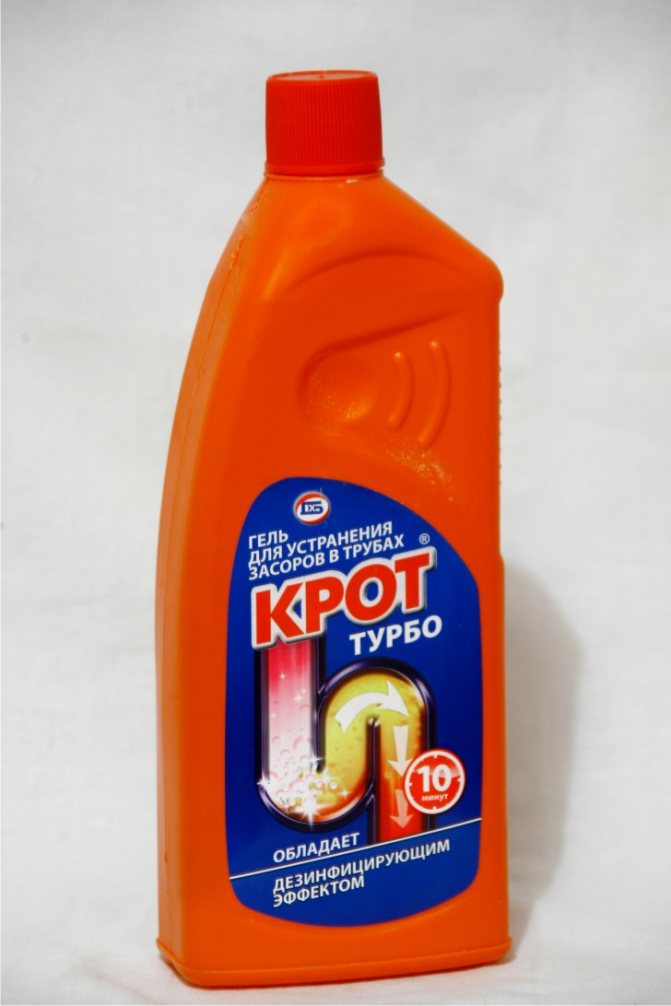

Means "Mole"
How to clean outside
A good housewife makes sure that everything in her house is perfect, including the radiators of the heating system. To eliminate the need to frequently wipe the dust in hard-to-reach places between the segments, the batteries are covered with special screen boxes. If there is no such design, you will have to arm yourself with improvised means.
Dry cleaning
The procedure consists in using auxiliary tools that are in every home:
- A vacuum cleaner. Thinking about how to clean the accordion battery inside, between the segments, nothing comes to mind except the ubiquitous vacuum cleaner. A reliable assistant will cope with dust deposits, and special small nozzles will make the process quick and comfortable.

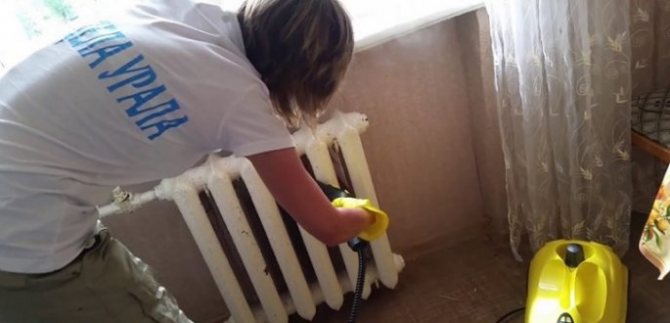
- A hair dryer is a hair dryer capable of blowing out all the accumulated bins of the battery accumulated over the years. It should be mentioned that the dust that has settled nearby will have to be removed with a vacuum cleaner.
- Pipidastre is a fluffy panicle with a cheerful color designed to brush away dust from fragile things that cannot be wiped off or this is due to a long painstaking process due to the complexity of the shape. It will also help in the fight against dry dirt in the radiator.

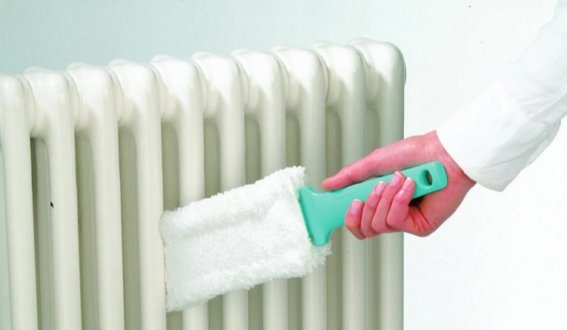
Wet cleaning
- The sponge is used with water or auxiliary detergents. You will have to try hard to reach hard-to-reach places of a complex-shaped product made of cast iron or other alloy.
- The brush is suitable for multi-row battery devices, such as bimetallic ones. In the gaps between the plates, a thin brush will pass easily and shake off the dust.
- It is convenient to clean the holes with a brush, and to avoid splashes, it is enough to wrap the tool with a cloth.
- A microfiber or cotton rag is also used with water or liquid detergents.
- A kettle with boiling water will help to rinse the entire product as soon as possible. It is only necessary to put a drip tray under the battery.
- The steam generator is a modern attribute that is not found in every home, but it is a useful multifunctional assistant in everyday life. It will not only clean, but also remove all pathogens from the surface. The floor and wall behind the battery must first be covered with foil and cloth. Textiles will absorb moisture that has got on it, and polyethylene will not damage the wallpaper or flooring.
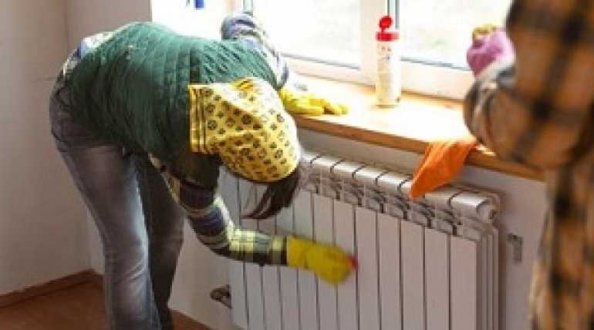

Chemicals and folk remedies that can be used to wash stubborn stains on the battery:
- vinegar;
- oxygen bleaches;
- liquid or dry substances marked "Anti-fat";
- washing powder;
- a strong solution of laundry soap;
- baking soda gruel;
- diluted chalk;
- citric acid - 3 tsp for 200 ml of water;
- peroxide.
It is interesting: 9% table vinegar even fights mold, which is important in areas with a humid climate. It helps to flush out old dirt.
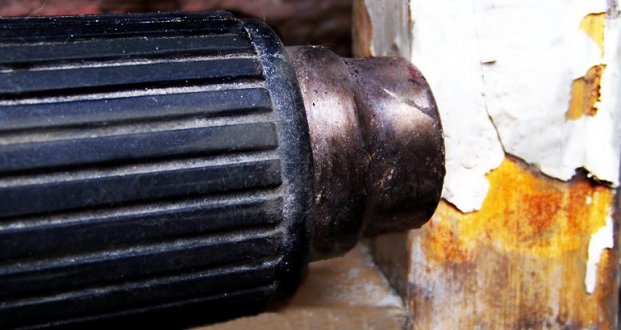

Methods for cleaning radiators inside and outside
The least questions arise when cleaning structures from the outside. It is enough to wipe the surface at least once a week with a damp cloth or sponge, and then with a dry clean cloth. Radiators in the kitchen additionally need to be cleaned of layers of fat - warm water with a few drops of dishwashing gel will cope with this task.
How to clean a heating battery of a complex configuration (for example, an "accordion") from the inside, we will consider below.
First of all, remove the protective shield that hides the radiator (if any). It is most convenient to rinse the grate in the bathtub and then wipe it dry with a clean cloth. To wash off the dust, warm water is enough, and a soapy solution will remove heavy dirt.
1. Vacuum cleaner. Dust accumulated between the sections of the housing is easiest to remove with a vacuum cleaner. It is great if the equipment is equipped with narrow nozzles that will crawl even into hard-to-reach places.
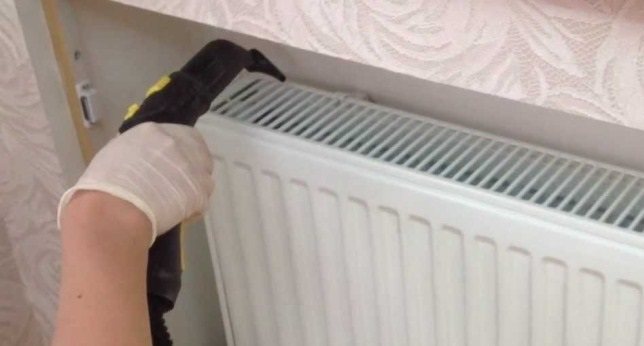

A vacuum cleaner with a nozzle is the simplest and safest solution
2. Hair dryer. This method is no less effective: hang a large damp rag behind the battery (best of all, a cotton - an old pillowcase or diaper), not forgetting to cover the wall with a waterproof film. Now carefully blow the radiator with a hairdryer: the dirt lurking in the corners will settle on the rags.
Such elementary methods are good if the battery is not running, and are suitable for weekly cleaning, and the whole process takes from 10 minutes to half an hour.
3. Boiling water. Boiling water will help to wash the batteries inside (especially if a large amount of dirt and grease has accumulated on them). Prepare a deep and wide baking sheet (large saucepan), a kettle of hot water, and rags. Place a container for collecting water under the radiator, protect the wall behind the structure and the floor with plastic or stretch film. Carefully pour boiling water over the sections: along with the water, all the dirt will drain into the makeshift tray.
Do not forget to protect your hands from hot water with heavy duty household gloves!
4. Soaped gloves. Experienced housewives offer a simple but effective solution: manual cleaning using fabric (household or ordinary, worn out) gloves. Put them on your hands, saturate with soapy water and use your fingers to scrub the dirt that has accumulated between the sections.
5. Steam generator. The steam generator will cope with dirt and grease on the heating radiators excellently. To prevent hot steam from spoiling the painted or papered wall and baseboard, cover all surfaces with foil.
6. Special store products. Store products (sprays, as well as solutions that can be poured into a spray bottle for convenience) help to thoroughly disinfect and clean the battery. Make sure that the composition for removing dirt and grease is suitable for the material from which your radiators are made (aluminum, bimetal, cast iron).
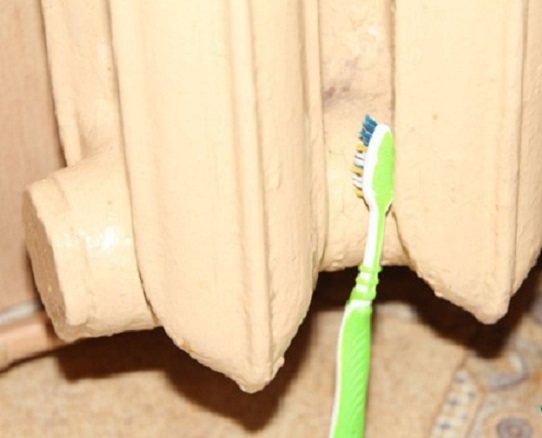

The method of the most patient
Technology: generously apply the product outside and inside the case, leave for the prescribed time (according to the instructions). Then wash off the remnants of "chemistry" and dirt in the manner described above, or simply wipe the cleaned surface with a dry cloth.
The surface of modern aluminum and bimetallic radiators is smooth and even, which cannot be said about cast iron. In order not to injure your hands with irregularities and "burrs" that are on the cast-iron surface, wash the battery carefully, without rushing.
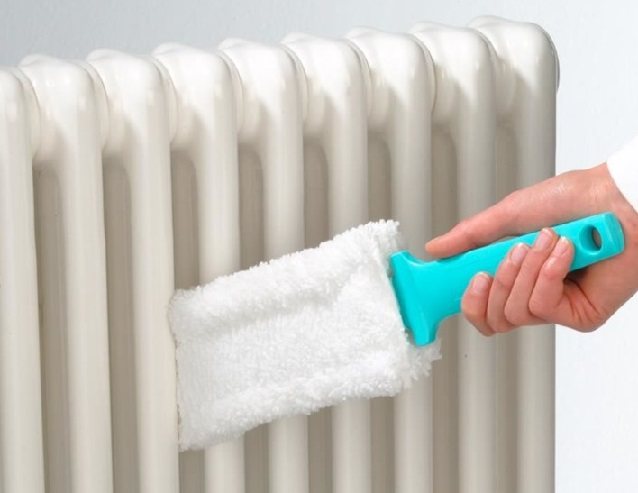

Special brush saves time
To thoroughly clean all sides of the batteries, buy a special curved brush from your local hardware store. As an alternative, any similar improvised tool is suitable: an old toothbrush, a "brush" for washing bottles, a brush for painting radiators, a ruler, the end of which is wrapped in rags.
Recommended: 4 reasons not to wash your windows in sunny weather - why is it better to postpone cleaning?
How to manually clean old paint from a battery
Cast iron radiators, due to their long service life, are periodically tinted. The high temperature with which the material is constantly in contact forces the coating to warp and all this takes on an unpresentable look.
There are several ways to quickly get rid of the old protective layer on cast iron:
- A paint remover like White Spirit will do the job. But you have to sweat, erasing everything or make lotions with this substance. The drug has a pungent unpleasant odor, therefore, the procedure must be performed with the windows open.
- Sandblasting is not difficult if there is a special device, which is rare. It is enough to shove the nozzle into the radiator, and it will do everything by itself.
- Building Hair Dryer - This is a thermal method and can damage the rubber dock seals between the segments.
- The drill attachment in the form of a brush is not the easiest method of mechanical cleaning, but it is effective. The main thing is not to overdo it, otherwise you can damage the cast iron.
In order not to have to frequently clean the radiators, you need to choose a special heat-resistant paint.
Having learned how to clean the battery inside and out, you should have patience and time before organizing an event. In both cases, the process is lengthy and sometimes dangerous. Especially if cleaning is carried out during the heating season. When you have doubts about your own abilities, it is better to seek help from a plumber.
Battery cleaning brushes and sponges
The following will help to remove old stains:
- Toothbrush, brush or narrow paintbrush with stiff bristles. They are able to crawl into the most remote corners of the radiator.
- Sponge. Attached to a long ruler, it can also clean hard-to-reach areas.
- Rubber glove. You need to put it on your hand and wash it well with laundry soap. Then use your fingers to wipe off stubborn stains on the heater. Can be replaced with old cropped tights or socks.
- Dishwashing brush. Use this brush to clean the battery. They are available at hardware stores and have a comfortable long handle.
- Spray. In order to wash the old batteries inside, it is necessary to add detergent to the spray bottle and spray the dirt. Wait for a while and wipe the soaked areas with a damp cloth.
Before using cleaning chemicals, you should carefully read the composition. Since it may contain aggressive active substances that can easily destroy the surface of the radiator.
Signs of clogging
Obvious signs of clogging are found inside the heater. For the system to function normally, nothing should interfere with it.
All dirt begins to settle at the bottom of the battery. The temperature of the sections decreases, the heat is not supplied.
Signs of clogging of heating devices:
- The supply pipes, and the aluminum batteries are cold.
- In the next apartment, the windows are opened because of the heat in the room, and in yours it is very cold.
- The radiator warms up unevenly. The sections above are hot, below are barely warm, and the very last ones are completely cold. They have different temperatures.
- The system warms up longer than usual.
- The boiler consumes more gas or electricity.
In addition to clogging, the cause of abnormal water circulation in the heating system can be an air lock, a malfunctioning shut-off valve, an unregulated system, or insufficient pressure.
Also, the batteries can be cold if there are technical faults outside the apartment.
Before flushing heating radiators, make sure that the cause is a blockage.
Hot water, circulating through the heating pipes, interacts with the metal and promotes the occurrence of chemical processes. As a result, deposits appear on the internal surfaces of the batteries, which impede the operation of the system and the heating of the premises in the apartment. In cast iron pipes, a blockage is formed due to foci of corrosion, which destroys the metal and settles on the walls in the form of tiny particles. On the internal surfaces of aluminum or steel radiators, deposits are formed due to the precipitation of calcium and magnesium salts.
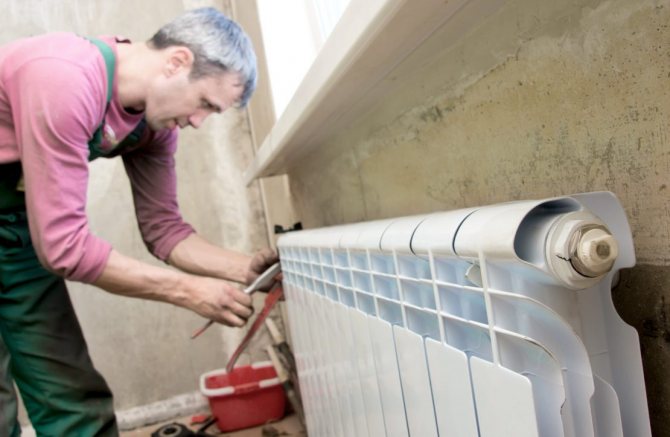

In addition, the poor quality of the heat carrier contributes to the clogging of the heating system. Together with water, particles of sand, and scale from welding, and other types of contamination move through the pipes, especially if the communications are old. Over time, all elements of the heating system silt up and need cleaning, which can be done with your own hands.
If the network is not cleaned in time, then in addition to reducing heat transfer and increasing energy consumption, the mechanical wear of communications is accelerated.
What is required?
To flush your own heating system without disassembling radiators, you need specialized equipment (CIF), which is called cleaning in place. It is necessary for the pump to give direction to the movement of the fluid in the system. The installation is a plastic container with a pump.In addition, you will need a rinsing solution. It will be poured into the tank, the system will be filled with a pump.
Such equipment is chosen based on several factors.
- The cleaning system shall be automatic with pulse control for rinsing.
- The body of the product must be resistant to the use of various disinfectants.
- Dimensions and weight are important, because with large dimensions it will be difficult to use the equipment. The best option would be 7-8 kg.
- It is desirable that the device has an indicator of pressure and water flow, the presence of a reverse flow.
- The capacity should hold between 10-20 liters.
We suggest that you familiarize yourself with Which heating radiators to choose - aluminum, steel or cast iron
If you plan to mechanically clean the radiators, you need to prepare a container for draining dirty liquid, unnecessary old rags that absorb moisture well, as well as polyethylene, so as not to harm the floor covering at the place of cleaning or along the movement of the radiator for flushing. In addition, in the work you will need keys, a gas burner or a kerosene lamp, a hose for the size of the heating pipe, a cable for cleaning and an iron brush.
When using the chemical method, a reagent will be needed that does not destroy batteries, a compressor, an apparatus for introducing liquid into the heating system. They choose a reliable machine, saving money in this case can affect the quality of washing. This takes into account the type of cleaning material used.
Dismantling
You can clean cast iron batteries yourself. While this can save a significant amount of money, the work is difficult and does not guarantee that the central heating system is completely flushed out. Probably after a while, the blockage will again make itself felt and you will have to call a plumber.
How to wash cast iron batteries by hand yourself:
- Turn off the central heating system, let it cool down for a few hours. Radiators can be filled with very hot water, which can cause severe burns.
- Place old towels around the battery and a saucepan under the radiator so that any dirty water can drain into it.
- Turn the valves at both ends. You should be able to turn the thermostatic radiator valve (to adjust the temperature) by hand, but you may need to use a wrench to turn the other valve (shutoff), which will have a removable plastic cap. Make a note of how many turns it takes to close them, as you will need to turn them back the same number of times as when removing.
- With these valves removed, proceed to remove the nut that connects the thermostatic valve to the radiator. Then, using a wrench, open the outlet valve. Be prepared for a stream of dirty water.
- Transport the radiator to the bathtub or outside. If cleaning in the bathroom, place an unnecessary rag on the bottom and cover the drain hole with a mesh so that it does not become clogged with rust and dirt. Ask someone for help if the device is too heavy.
Dismantling is over, you can start cleaning cast iron or aluminum batteries.
We suggest that you familiarize yourself with How to clean the ventilation in an apartment yourself
Dry cleaning
Dry cleaning means daily cleaning. It is not difficult to clean the outside of the battery if you do it once a day or at least once a week.
Cleaning radiators outside:
- Together with the vacuum cleaner, there are special nozzles that can remove all the dust between the sections, if they are very close to each other.
- If you don't have a vacuum cleaner, you can use a hairdryer. We attach a damp cloth between the heating radiator and the wall. We direct the flow of hot air into the sections and blow out all the accumulated dust. Thanks to the damp cloth, dirt will not fall on the carpet, but will stick to the rag. Then we rinse the cloth in clean water and continue cleaning other appliances.
You can buy a special brush for heating radiators at the store. It will be easier for her to wipe off the dirt. It is equipped with soft sponges, which are very dense and allow you to clean the battery from several sides at once.
Reasons for flushing heating radiators
Below are the reasons why you need to flush the heating batteries:
- Uneven heating of the battery. It can be cold at the top and hot at the bottom, or vice versa.
- If you notice that the radiator heats up more slowly than before.
- The pipes that go to the batteries are hot, and the batteries themselves are cold.
- Energy consumption is growing markedly.
Heating radiators, based on such a criterion as the material of manufacture, can be bimetallic or cast iron.
The flushing method and how to flush the radiator does not depend on the material of their manufacture, however, for bimetallic radiators, it is best to use a chemical type flushing.
If we compare two types of radiators, then bimetallic ones have a lot of advantages. Their biggest plus is that their surface is not so rough, so they do not get dirty so quickly. Thanks to this, bimetallic radiators are more durable.
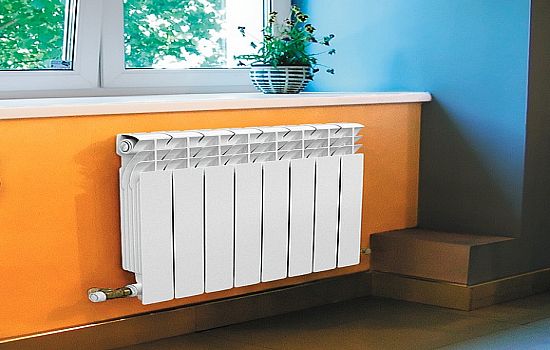

Bimetal heating radiator

